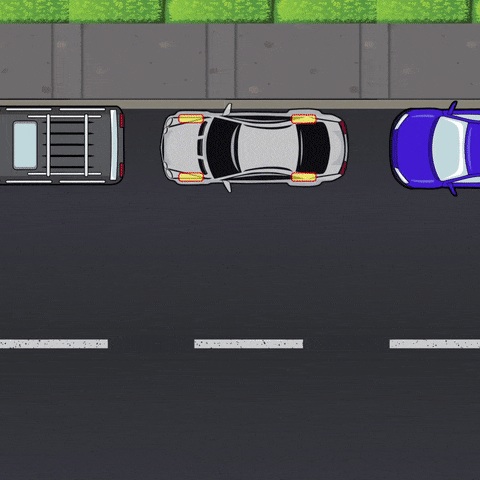
Parallel parking is one of the most intimidating driving skills for many young drivers, and plenty of people who have been driving for years struggle with parallel parking. For decades, the portion of the driver’s test that examined an operator’s ability to squeeze their car into a spot frustrated and failed new drivers. Parallel parking isn’t that difficult to master once you understand some of the basics and take some time to practice.
Many states decided to stop testing for parallel parking skill, both to allow more passing drivers and as an acknowledgment of the relative rarity of actually using the skill in real life. But for those who live in urban cities, being able to parallel park might be the difference between being home and circling for hours in search of an easier place to park.
As car enthusiasts, very few things are more anger inducing than coming out to your car and seeing that someone failed to parallel park correctly and backed into your car. Almost as bad are drivers who manage to parallel park, only to leave inches between their car and yours, requiring near Houdini-like extraction.
Many of today's newest cars include features that aid in parallel parking, and some that even do it without help. Knowing how to do it yourself is important, and a good driver should not rely on computerized systems to do tasks they can't. Learning to parallel park is not that difficult once you understand the basics.
Today, we are going to show off some tips and tricks to help you gain confidence in parallel parking and explain how to do it right the first time, every time.
The most important thing to learn about parallel parking is how to use your mirrors. You will use your mirrors to see what is around you, and most importantly, where in relation your car is to other cars, walls, curbs, and other fixed objects that you do not want to hit. You won’t rely on your mirrors, you will still need to look around, but knowing how to set your mirrors correctly so you can see the relationship between your car and the surrounding environment is pretty important.
Familiarize yourself with your car. Does the bumper stick out a lot, but can’t be seen while driving? Does the shape of the hood or trunk make it seem like your car is much shorter than it actually is? How much do your rims stick out from your tires? A workshop manual will give you the specific dimensions of your car and make it easier to recognize the size of a parking space you will need.
This can take time and experience to learn, but start by walking the length of your car to get a sense of how big it actually is, not just what your service manual says. When driving, and particularly when parking or making low-speed maneuvers, pay attention to what you can see in your mirrors and what you can’t. Knowing your car will make a big difference in parallel parking correctly.
The art of parallel parking relies on the driver’s ability to use the vehicles steering to accurately guide the car into a spot that typically will have objects on three sides; cars in front and behind, and the curb.
Reversing is often a fear of many drivers, but it is an essential skill to parallel park. Simply put, sometimes you get lucky and can pull in and park, but that is not something you should rely on. Instead, learn to parallel park like a pro and reverse into a space quick and easy.
A great way to practice this skill is in an empty parking lot where you can arrange barrels or cones to simulate objects, but you won’t cause damage if you misjudge the space.
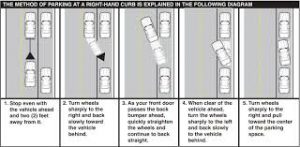 Parallel parking is an easy skill to learn when you follow these tips and tricks.
Parallel parking is an easy skill to learn when you follow these tips and tricks.Parallel Parking Made Easy
Step One: Staging
Picking a spot to park relies on your ability to tell how big your car is. If you stop next to the spot you are considering and you do not have at least three feet in front and behind, the spot is probably too small.
When you identify a spot you want to park in, position your car alongside the car AHEAD of the spot you want to park in so that the rear wheels are more or less even with the back bumper of the forward car or a little farther forward. Parallel parking is much easier in reverse, as the turning wheels guide the car rather than dragging the length of the car when you try to pull in and park. This step isn’t exact science, and depending on the shape of your car, you might have to pull forward less or more.
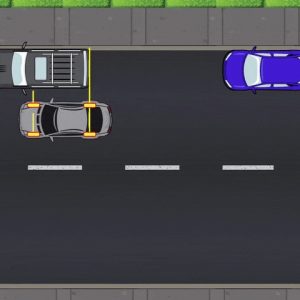 Aligning your car is the first step to parallel parking correctly.
Aligning your car is the first step to parallel parking correctly.You will want to start out as close to the parked car as you can comfortably get without hitting anything. Starting out farther away will put your car at an awkward angle that is often difficult to correct when parallel parking.
Step Two: Angled reverse
Time to use those Mirrors!
This is going to take patience and lots of stopping. So start out stopped. Shift into reverse and turn the wheel gently toward the spot you want to park in. It isn’t necessary to spin your wheel all the way at first, instead turn slowly so that the rear of your car angles into the spot. The trick is to get the back wheels headed toward the curb so that you can turn the front wheels in without hitting the parked car in front and before impacting the curb. This will look right when you look over your shoulder and see the curbside edge of the rearward cars bumper about in the middle of your rear window.
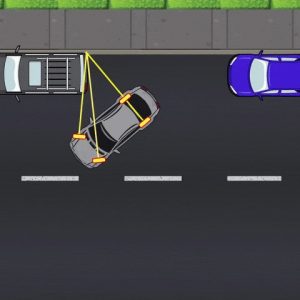 Turning your wheels and reversing will get you started to a perfect parallel park.
Turning your wheels and reversing will get you started to a perfect parallel park.Avoid having the front of your car jutting out into traffic by making the turn gradually. Practice makes perfect, but you should very quickly realize that by getting close to the parked cars and aligning your rear wheel at the back of the front car, you will not hit anything and you will have the optimum angle to guide your car into the spot.
Step Three: Turning the Nose
Before you hit the curb –or the car behind you- and once the front of your car is clear of the car ahead, begin turning your wheels the opposite way you started while continuing to back up. When done correctly, the nose of the car will come into the space before the back of the car hits the vehicle behind and the wheels will not drag on the curb.
When it happens just right, it is a thing of beauty- almost like a magic trick you don’t understand- but totally believe.
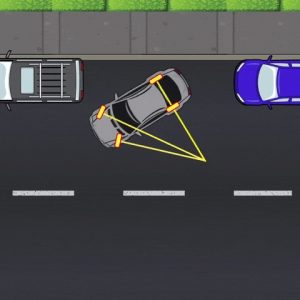 Turning the wheels the opposite direction will get you into that spot.
Turning the wheels the opposite direction will get you into that spot.
Parking Boss Tip-Do not be bashful- get out and look around if you are not confident how much clearance you have. If you see that you are almost hitting the car behind, but the nose of your car is not clear of the car ahead, the spot is too small. If your rear tire is against the curb, you will need to pull forward enough to allow the car to turn into the space without hanging up on the curb. Do not drive over curbs in an effort to make parking easy. You can destroy your wheels, lose control and hit someone, and even get stuck in soft grass or gravel and have to get a tow.
If you realize that your car is all out of whack and you are going to have to make Austin Powers-like back and forth maneuvers to park, just start over. It is a lot less hassle. If you are worried about being judged by people watching, remember, you are responsible for parking your car correctly. Be Confident. Don’t let the impression of others influence your ability to park safely. Parallel parking can be hard for everyone.
Step Four: Aligning it all
Begin to straighten the wheels as you move forward. If you drive a car with power steering, you can do this stopped. If you are old-school, give it a little love as you move forward- but gently! Align your wheels even with the curb for flat ground, or according to the slope of the road, in or out, as the situation demands.
At this point, you are in! But, you are not done. Before walking away, make sure you did not park in such a way as to make it difficult or impossible for other drivers to get out of the spot they are parked in. If you are really close to one car, but far from another, even it out. In some cities, parking enforcement can tow your car for parking too close to other cars. At the end of the day, it is simple courtesy to make sure you don’t make it more difficult for someone else than it needs to be.
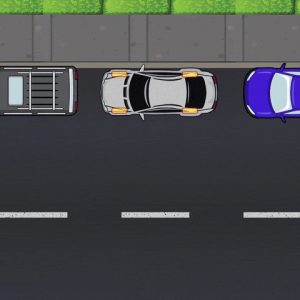 Make sure you do not park your car so that other drivers can't get out.
Make sure you do not park your car so that other drivers can't get out.Conclusion. It Really Is Not That Hard
Practice makes perfect. Once you really understand how to use your mirrors- and know where your particular cars long and short-comings are in terms of visibility- parallel parking is an easy skill to master, and your friends will call you a boss when you whip that ride into an itty-bitty little spot that dozens of other drivers lack the confidence to try.
